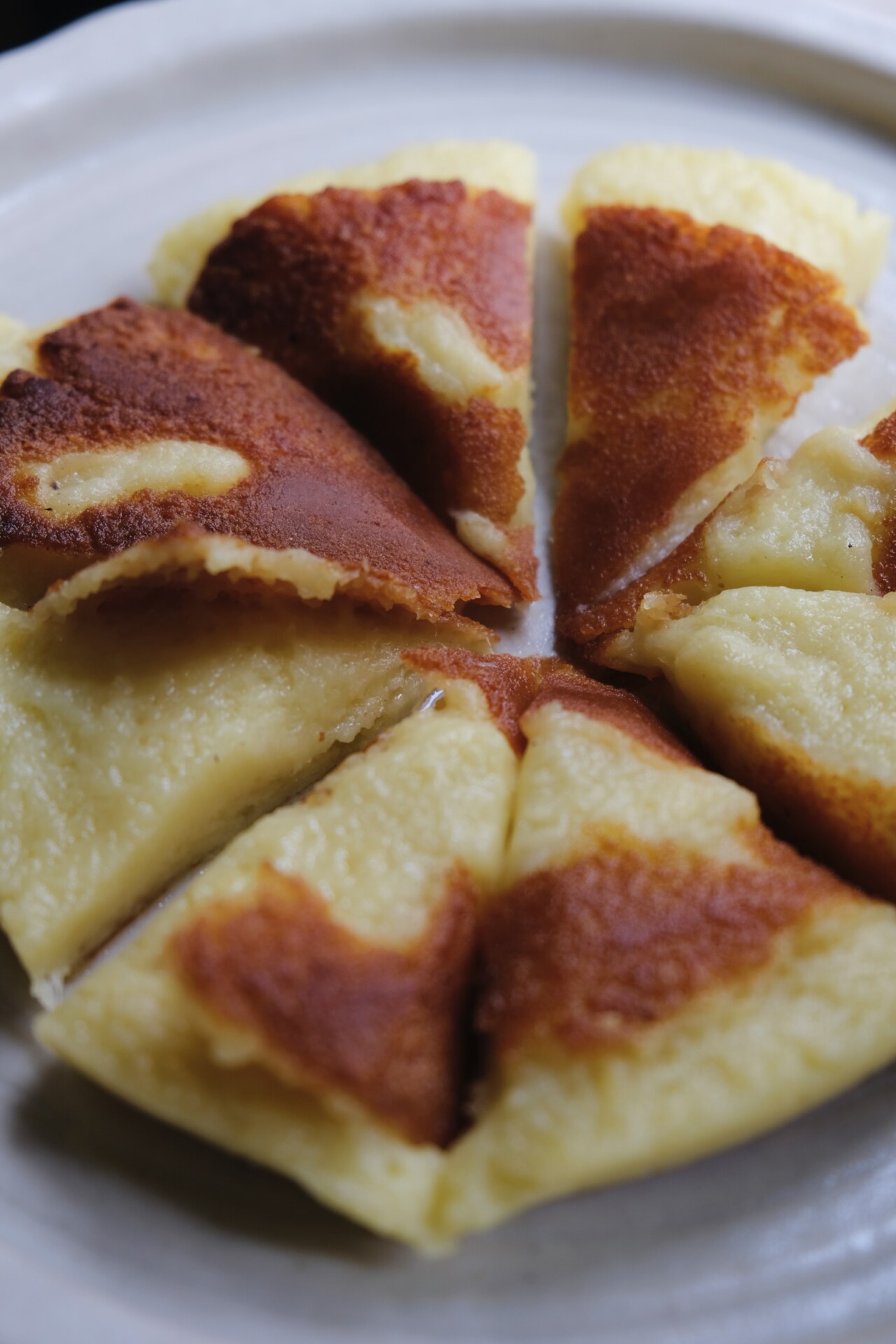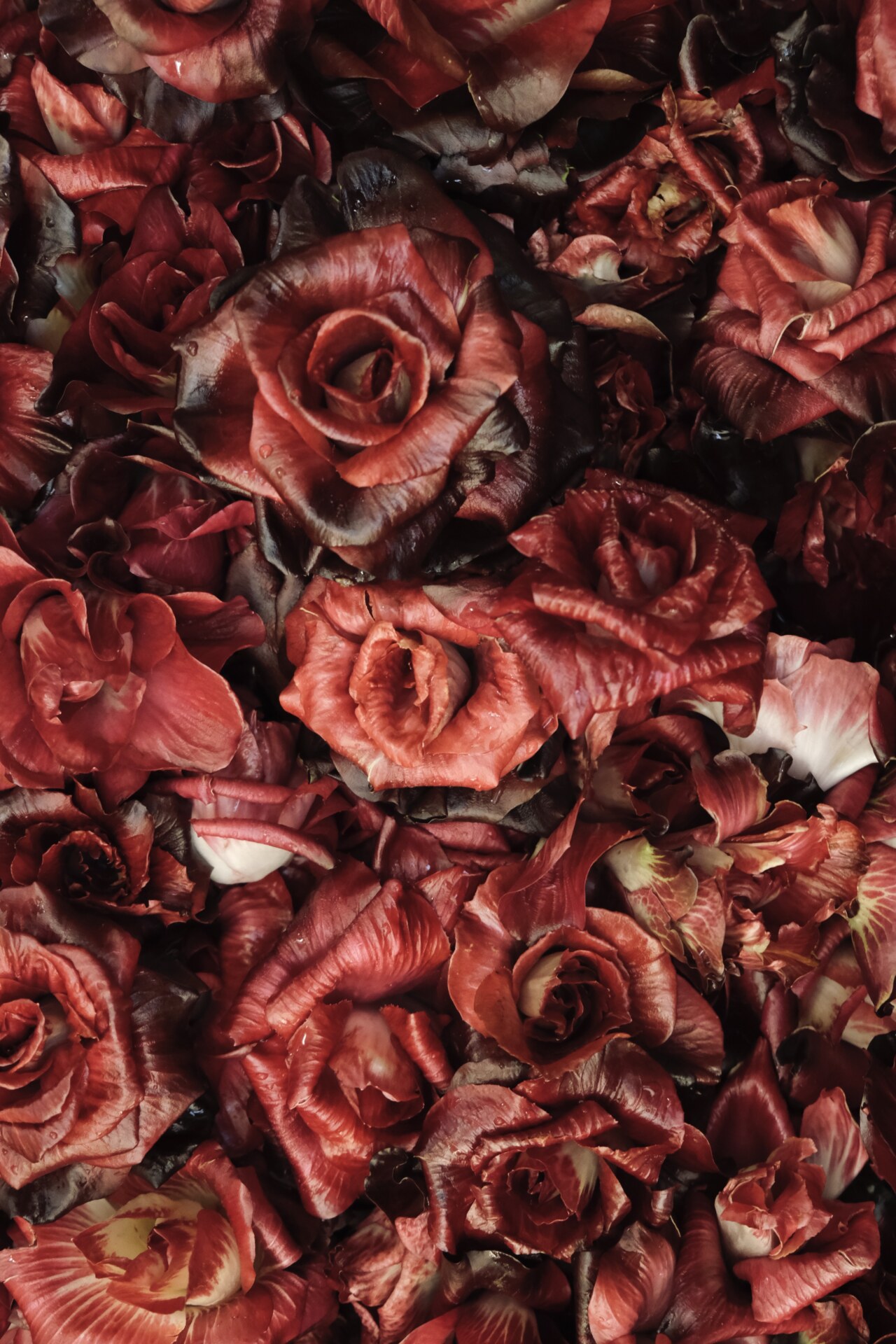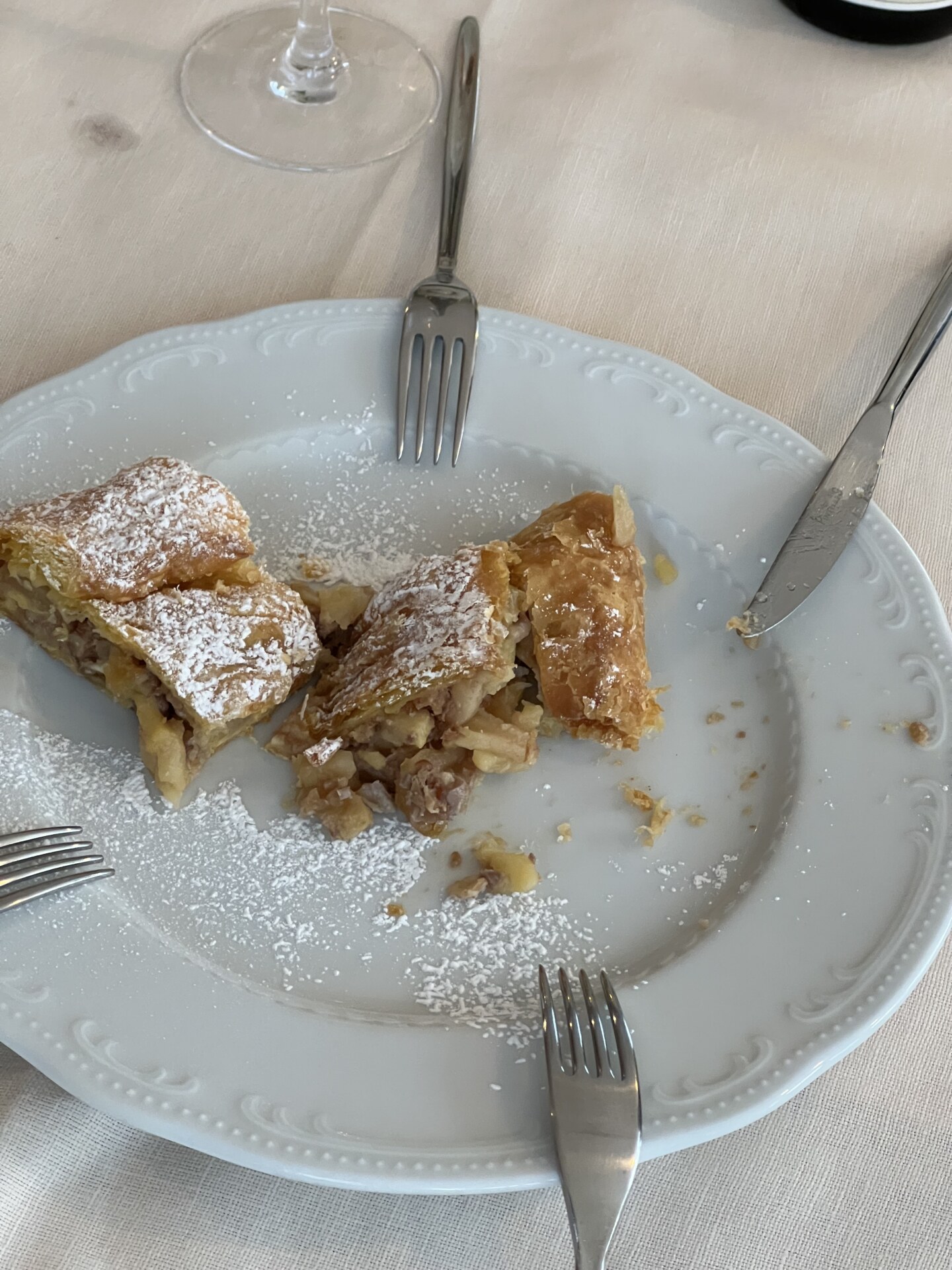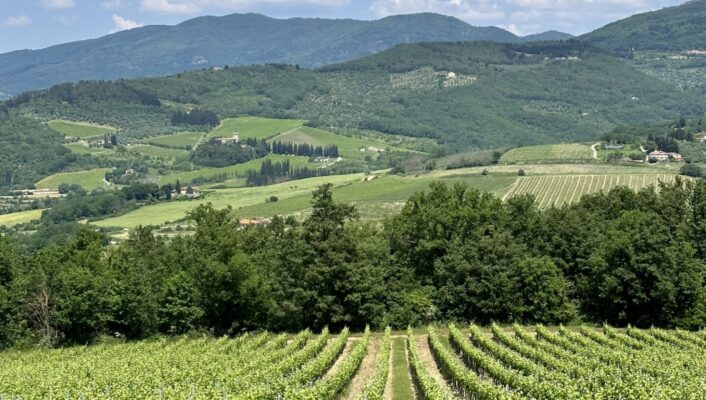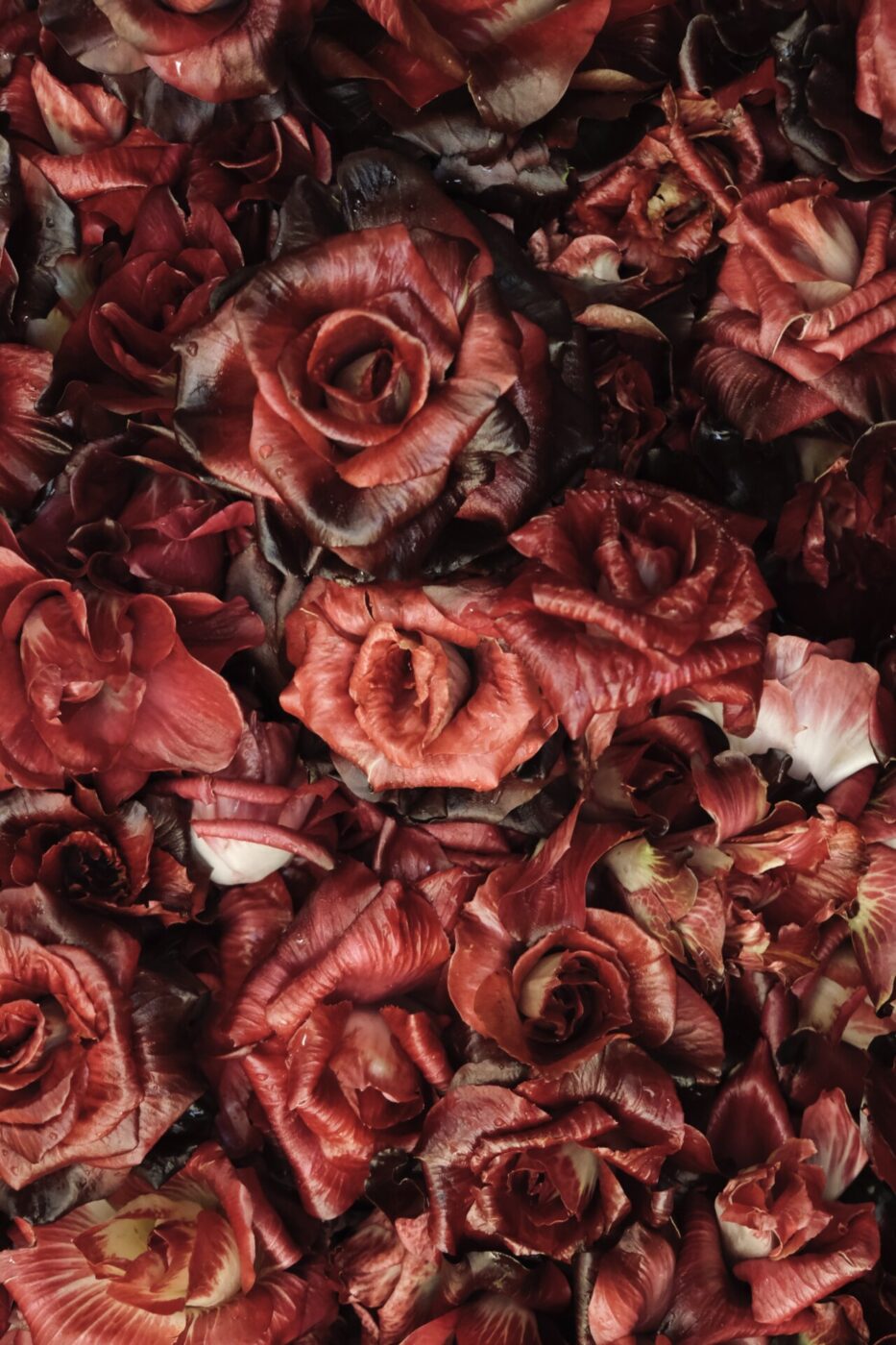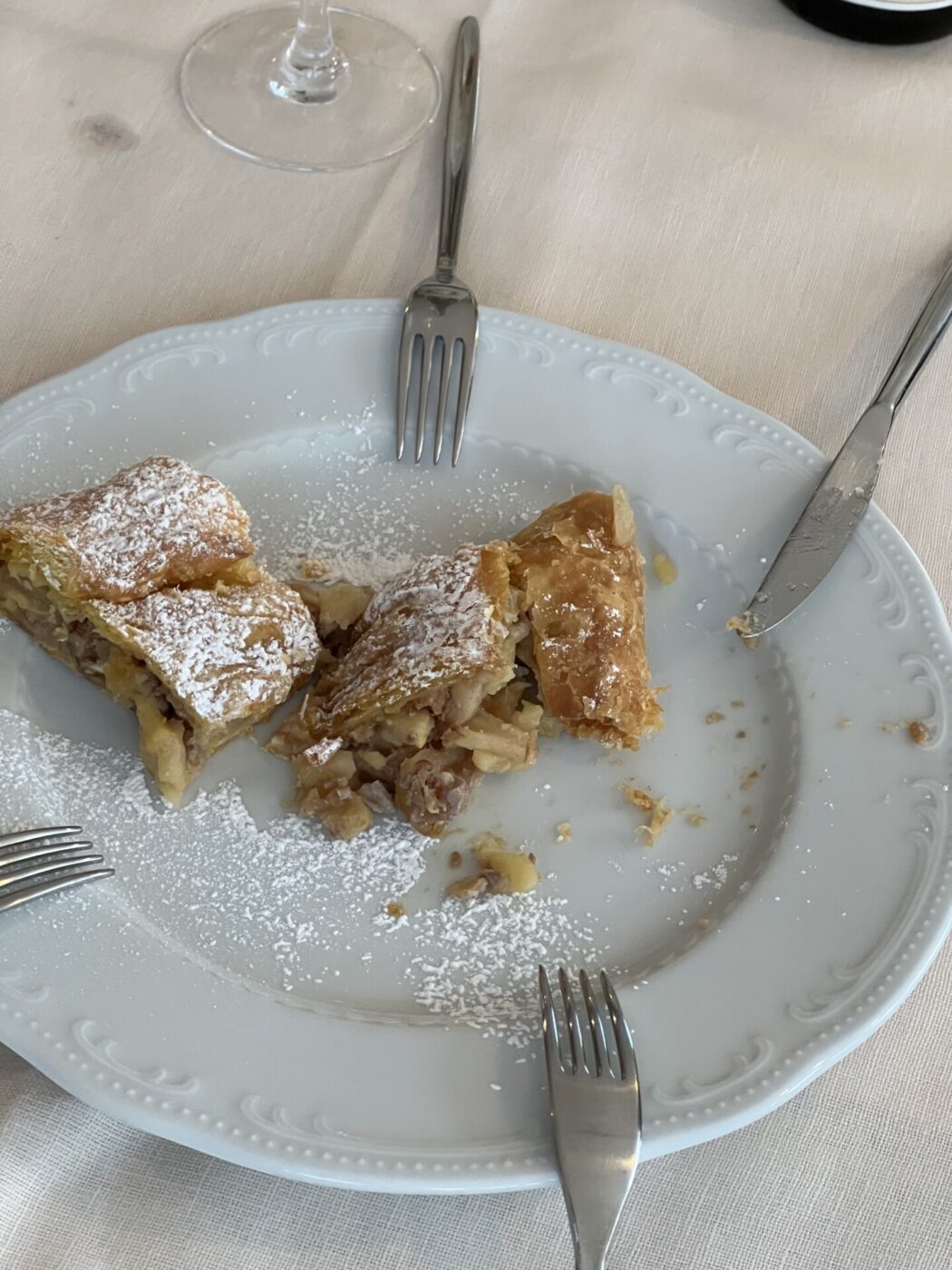Friuli-Venezia Giulia may be small–just 7,924 square kilometers–but it certainly is mighty when it comes to food. Nineteenth-century journalist Ippolito Nievo famously called the region a “small summary of the whole universe” and even a brief visit is enough to see that Friuli really is a rich patchwork of peoples, languages, topographies, and foods.
The lofty peaks of the Carnic and Julian Alps give rise to hearty soups and stews and economical dishes that use the seasonal ingredients on hand. From the rolling foothills come world-renowned delicacies like Prosciutto di San Daniele. The coasts of the Adriatic bear sumptuous seafood plates like baked spider crabs and scallops. Neighboring Venice inspired cousins of cicchetti, while borders with Austria and Slovenia imparted goulash and Balkan delicacies like ajvar and ćevapčići, respectively.
The complexity created by this diverse landscape is compounded by Friuli’s historical position at the heart of Middle Europe. Peoples from all across the continent either inhabited the land or crossed through on their trading routes–including ancient Celts and Romans, Germanic Langobards, Venetians of La Serenissima, French of Napoleon III, and those of the Austro-Hungarian Empire. Traces of all can be found in the kitchens here.
Given the vast range of Friuli’s culinary canon, it was hard to narrow this list down to just 20. So these are just a few of the foods that exemplify the diversity of the region and that you can’t miss trying while in Friuli-Venezia Giulia.
FRICO
If there’s any dish that screams Friuli, it’s frico, a simple, thrifty dish created by the mountain folk in the 15th century to use up leftover cheese rinds and potatoes. Grated Montasio cheese, potatoes, onions, and sometimes pancetta or other cured meats are cooked in a frying pan until the edges of the pancake-like disk are crispy and the crust golden-brown. For those of us who purposefully burn anything cheesy to get those crunchy bits, it’s an absolute dream. Keep in mind that the term “frico” refers to both this soft and thick dish, as well as thin, brittle cheese shards that can be snacked on at the start of a meal or used for garnish.
PROSCIUTTO CRUDO
It’s no secret that Friuli makes some of the best crudi in Italy. The center of it all is the town of San Daniele, famed for its Prosciutto di San Daniele, a cured ham made from the pig’s hind legs and aged for at least 13 months. It’s said that the area is a crossroads for the cool winds of the Carnic mountains and the warm, briny breeze of the Adriatic, which, combined with the thermoregulatory force of the nearby Tagliamento river, allows for the perfect production environment; it has garnered international renown for a reason. But we will let you in on an insider’s tip: we prefer Prosciutto d’Osvaldo. First developed by Cormòns local and butcher Luigi D’Osvaldo in 1940, the crudo’s production is carried on by Lorenzo (Luigi’s son), his wife, and his children. At its inception, Luigi had to import a smoking system from eastern Europe, as none were available here, which today is furnaced by a mixture of cherry and laurel wood. Delicate, sweet, and tender, it might just be the best prosciutto we’ve ever had.
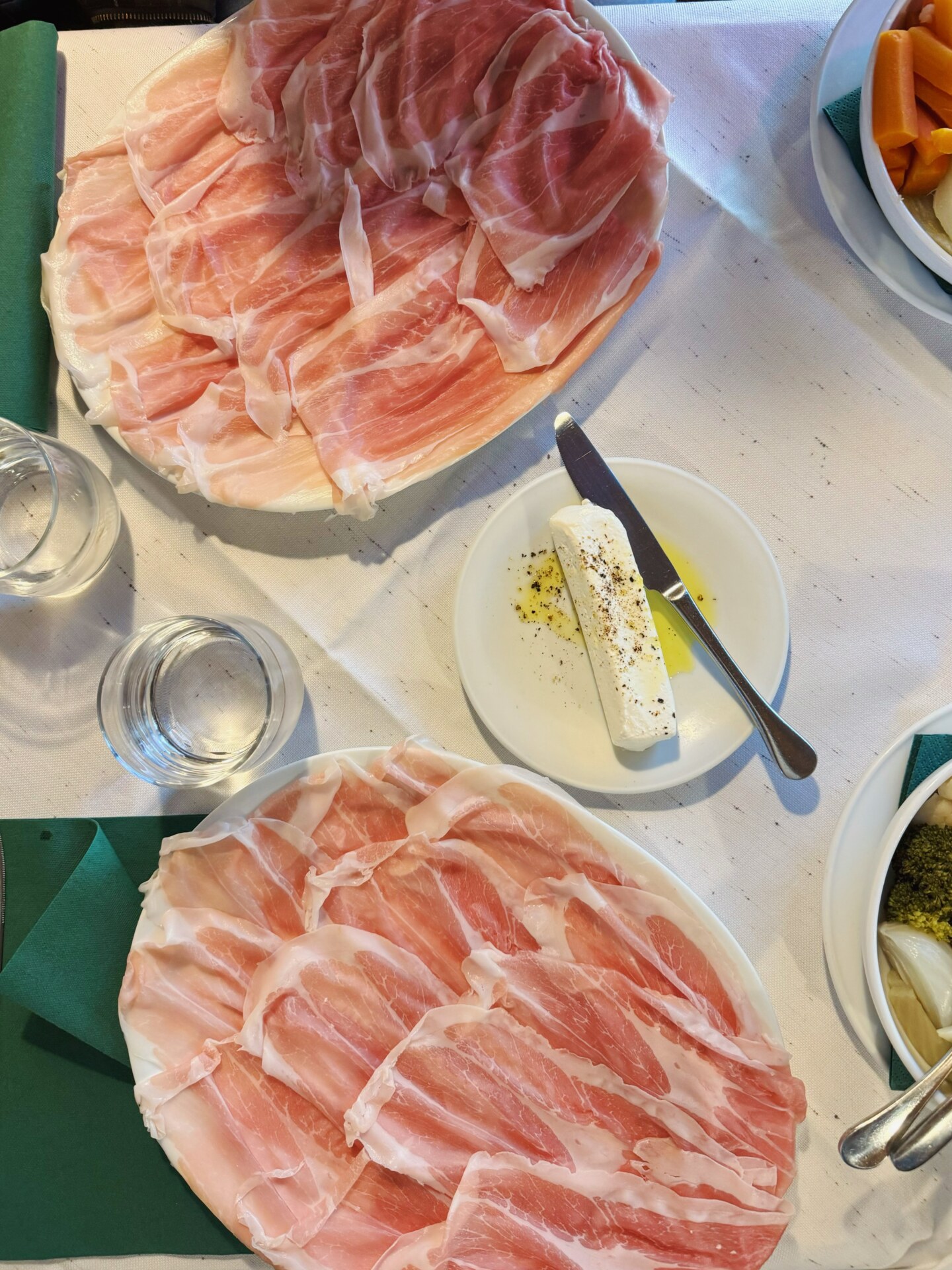
Prosciutto San Daniele 20 mesi, Cordazzi
STRUCOLO
Dough, spread with filling, rolled up on itself to form a cylinder, and boiled, strucolo comes in both savory and sweet variations. The salty ones can be found as a primo, filled with some combination of ricotta and cheese, vegetables like peas or spinach, and meats like veal or beef. Season these with butter and cheese. The sweet ones, on the other hand, can be stuffed with anything from fresh or dried fruits (the apple ones are great!) to chocolate, walnuts, and raisins–all finished off with a topping of butter, cinnamon, and sugar. The word “strucolo” has its origins in the cultural exchange between Istrian Italians and Slavic communities, and is derived from the Slavic term “strukllj,” which itself was influenced by the German word “strudel.”
BLECS
Every family in Friuli has their own way of making this handkerchief-looking pasta, whose name comes from Friulian for the “patches” used to mend clothes. All recipes, however, require the use of three types of flour: white flour and buckwheat flour make the dough, which is rolled out and roughly cut, while the pasta is historically seasoned with “morcia”, a crunchy garnish made by cooking corn flour in butter (and sometimes sage). Others, however, may sauce these maltagliati-esque sheets with a goulash or ragù di cervo, made with local deer.
CJARSÒNS
Within the mountainous expanse to the north of the region is the cultural enclave of Carnia, settled by the ancient Romans and historic home to the cramârs, traveling spice peddlers who crossed the mountains on foot, bringing spices from Venice to Austria, Germany, and Hungary. Upon returning home, the cramârs would empty their crassigne, or spice boxes, and with the bits and bobs leftover, the cramârs’ wives would make cjarsòns in celebration. These sweet and salty ravioli may be filled with anything from ricotta to jams, herbs, fruits, and nuts and spiced with cinnamon, chocolate, and cloves.

Cjarsons
AJVAR
A regional variation of the traditional Balkan ajvar, this smoky sauce is most often spread on bread or as a condiment for grilled meats and ćevapčići. (The latter is another must try! This local street food is like a sausage-shaped kebab of minced beef and lamb, seasoned with garlic, onion, paprika, white wine, and olive oil, then grilled.) Made of charred peppers and eggplants, chilies, garlic, oil, and vinegar, ajvar is often made in late summer or early autumn when its titular ingredients are at their peak flavor. Jarred to last through the winter, ajvar is an essential Friulian preserve.
MONTASIO CHEESE
Named after the Montasio plateau in the Italian Alps, this DOP raw cow’s milk cheese comes in three age categories: fresco, aged for 2-4 months, mild and slightly sweet; mezzano, aged for 5-10 months, with a firmer texture and a more full-bodied flavor; and aged, for more than 10 months, a harder variation with a strong, sharp flavor. The cheese is most famously used for the aforementioned frico, but also makes for a great table cheese or addition to pasta, risotto, and other traditional plates.
PAPAROT AND ZUF
This poor dish from Pordenone, made with the few ingredients farmers would historically have on hand, is a cornflour-based primo, similar to polenta, enriched with a handsome portion of cooked spinach, a knob of butter, and a garlic clove or two. Another cornflour-based local dish is zuf (which in Friulian means “mixture”), a hearty pumpkin porridge eaten for breakfast with a sprinkling of sugar on top. The preparation involves combining mashed pumpkin with a mixture of flour, cornflour, water, and milk, gently simmering it until it achieves a creamy consistency; sometimes a few leaves of sage are added as a flavor enhancer.
ROSA DI GORIZIA
At the edge of Slovenia, you can find a rare wintertime crop: a rose-shaped radicchio known as the Rosa di Gorizia. Introduced by the Habsburgs in the late 19th century, this deep-red chicory, which only grows well in a small slice of land, is most often found dressed with ciccioli–pieces of prosciutto or pork lard, cooked down with balsamic vinegar–so that the rich oil coats the rosy leaves.

Rosa di Gorizia salad
GRANSEOLE AND CAPESANTE ALLA TRIESTINA
A delicacy of Friuli-Venzia Giulia’s capital, granseole are broiled spider crabs simply seasoned with oil, parsley, salt, and pepper. These delicate crustaceans are best in spring, when their pulp is at its richest. A similar preparation is made with capesante, or scallops, though the oil is subbed for butter and breadcrumbs are sprinkled atop before baking.
WHITE ASPARAGUS OF TAVAGNACCO
A sure sign of spring in Friuli is white asparagus, commonly planted here to absorb excess moisture in the soil. Here, the delicate stalks might be wrapped in Prosciutto di San Daniele or served alongside an egg salad, lightly dressed with vinegar and olive oil. To be in the center of the white asparagus action, head to Tavagnacco, just north of Udine, where the Festa degli Asparagi is held annually.
GUBANA
Stuffed to the gills in Friuli? Locals will tell you you’re “plen come une gubane”–“full like a gubana” in the Friulian language. A celebratory pastry ring typical of the Natisone Valleys, which stretch from the far east of Friuli to the Alps, the snail-shaped gubana is prepared for Christmas, Easter, and other special occasions like weddings and local festivals. The sweet, leavened dough is filled with walnuts, raisins, pine nuts, sugar, grappa, and lemon zest, and dates back to 1409, when it was served to Pope Gregory XII at a banquet in Cividale del Friuli.
GNOCCHI DI PRUGNE
Widespread throughout the region, these sweet dumplings seem to come from the land of the Sugar Plum fairy–though in reality, they’re of Bohemian origin and were introduced to the area during the period of Austro-Hungarian rule. A simple potato-based dough is wrapped around a plum (fresh, when in season, or dried) and a pinch of brown sugar; after boiling, the dumplings are traditionally served with butter and cinnamon sugar breadcrumbs, though some garnish with grated smoked ricotta to temper the sweetness.
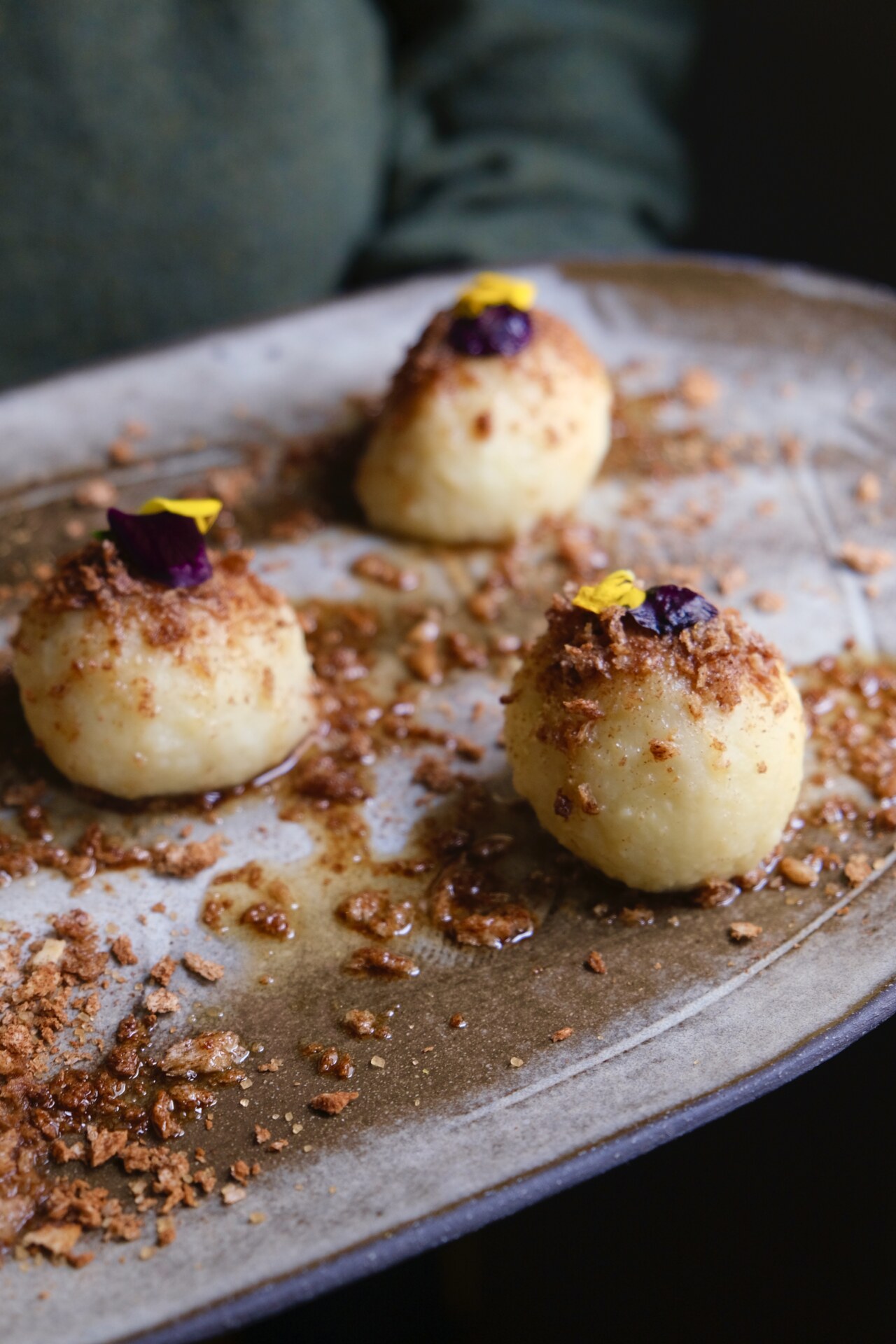
Gnocchi di prugne
PITINA
This IGP product is the lovechild of salumi and polpette. Pitina and its variations were born out of the need to preserve meat during the autumn and winter months in traditionally impoverished areas like the valleys north of Pordenone. When a chamois or roe deer was hunted, or a sheep or goat became injured or sick, every part of each animal had to be used. The meat would be minced in a pestadora, a hollowed out wooden stump that functioned as a mortar, and augmented with salt, black pepper, and garlic, and sometimes various herbs, spices, and red wine. Formed into balls, the meat was rolled in corn flour and smoked for several days on a fogolâr, an indoor hearth typical of Friuli. As time passed, the meat would dry up and Friulians would have to soften it in polenta broth before eating, though today, pitina is made more malleable with pork fat–which also works to tone down the gaminess of the meat. The stuff can either be eaten raw in slices, like a crudo, or cooked: seared in vinegar with polenta, browned in butter, or “al cao”, cooked in fresh cow’s milk.
SARDONI IN SAVÒR
Fried sardines preserved in vinegar and sweet and sour, cooked onions. Sounds familiar? This pungent antipasti can also be found by the name of sarde in saor in Friuli’s westerly neighbor of Venice. A method to preserve fish, which is more abundant during the summer months, savòr–and all its regional variations, including carpione, scapece, escabeche, and scapeccio–can be traced back to Apicius’s first-century BC recipe book De Re Coquinaria. (Find our recipe for the whiffy dish here!)
JOTA
This warming winter stew is eaten throughout the extended geographical area–including Friuli, Istria, Slovenia, and Croatia–but the most famous variant is the one from Trieste: capuzi garbi (sauerkraut) is cooked with borlotti beans and potatoes, and flavored with pork ribs or rind, cumin, and bay seeds. Though the name’s derivation is rather unappetizing–coming from the late Latin “jutta”, meaning slop–the soup is dense, full-bodied, hearty, and the perfect antidote to a cold Friulian day.
BROVADA
A thrifty dish if we’ve ever seen one. Purple-neck white turnips, “bruade” in Friulian, are fermented for 40 to 60 days in black grape pomace, the solid residue leftover from the winemaking process which includes skins, seeds, and stems. (If you’re familiar with the waste-not-want-not philosophy, you’d have guessed that brovada is made in fall, at the end of vendemmia, to preserve the root vegetables through the winter.) After fermentation, the turnips take on a pink color, and are grated and packaged (it’s been a DOP product since 2011). Friulians cook brovada with oil, bay leaves, and often a bit of pork, and serve it in soup or alongside roasted or boiled meats; during the Christmas season, you’ll find the stuff next to musetto, a sausage composed of off-cuts.
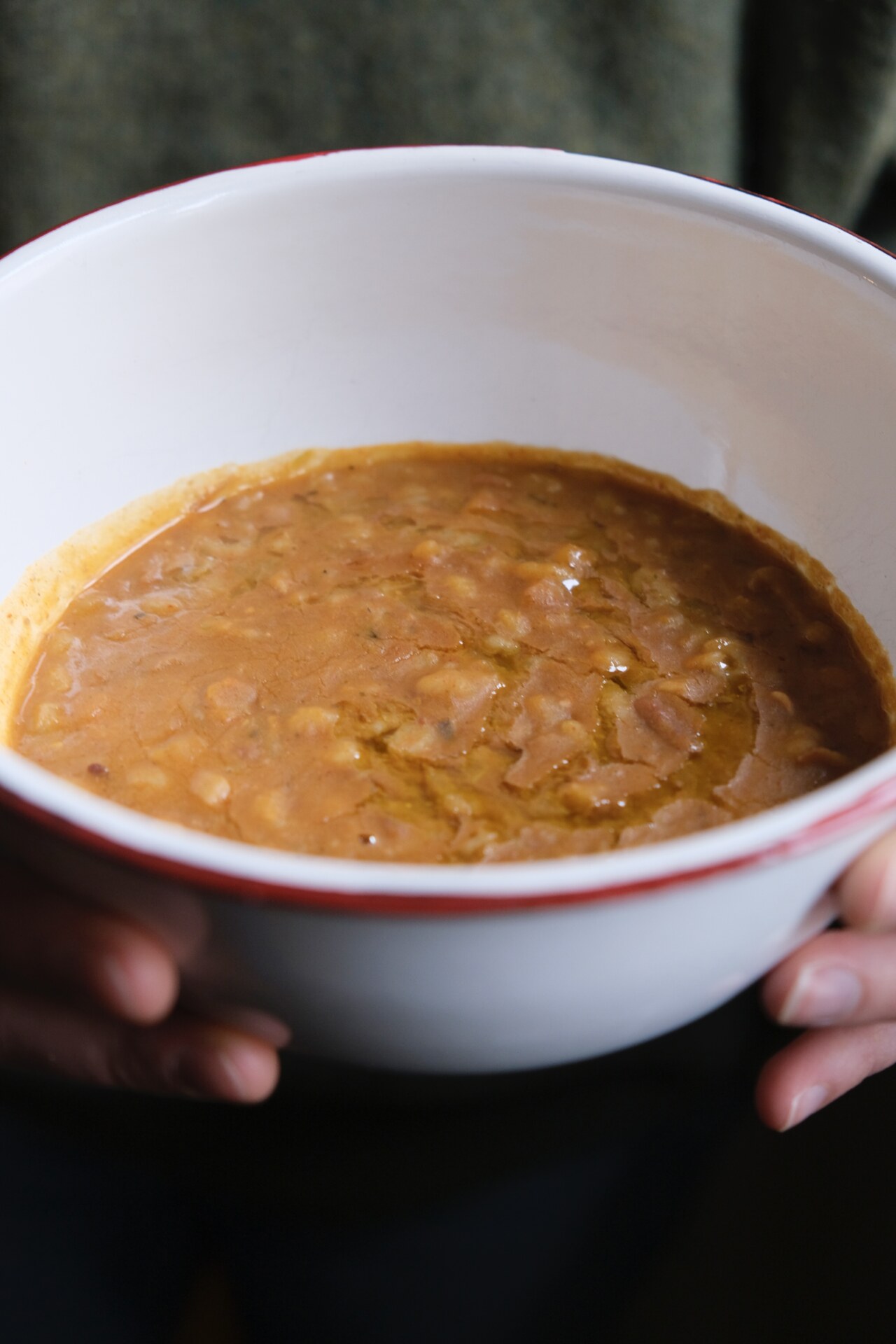
Jota
GULASH TRIESTINO
Anyone with a passing familiarity of Eastern European cuisine knows goulash, the paprika-heavy beef stew that originated in Hungary but has now become a beloved dish in many surrounding countries. The fact that the hearty plate made its way to Friuli is testament to the historical impact of trade on Trieste. The city’s “gulash” is a bit thicker, vegetable-less (i.e. tomato free!), and requires equal weight portions of beef and onions, differentiating it from its counterparts. You’ll find it served with polenta or potato puree.
DOLCE DI SPILIMBERGO
The recipe for this cake–pastry dough filled with a soft, delicate almond cream and finished with a heavy dusting of powdered sugar–is top secret. Trademarked by the originator, pastry chef Luigi Zambon, the dessert was developed in the now-defunct Nova pastry shop in Spilimbergo, and Zambon produces them today in an artisanal space dedicated exclusively to the sweet; its many admirers can order it online to be shipped. Imitations can be found in restaurants and bakeries around the region.
PRESNITZ
Hailing from the Trieste and Gorizia region, presnitz is flaky puff pastry rolled around a mixture of walnuts, almonds, pine nuts, figs, plums, apricots, raisins, grated chocolate, sugar, cinnamon, cloves, and a touch of rum. (The specific ratios here may vary depending on the baker, and you may find versions that resemble struccolo or gubana in flavor.) A typical Easter dessert, the circular shape is meant to represent Christ’s crown of thorns. Its creation can be traced back to the year 1832, when Francis I and the Empress of Austria were served the sweet for their visit to the capital. Initially inscribed with the phrase “If you travel the world, come back here,” the pastry was bestowed with the Preis Prinzessin (Princess Award). Over time, the residents of Trieste mispronounced this title as “presnitz”.
BONUS: WINE AND SPIRITS
Friuli is a region for wining and dining; all these foods are best accompanied with a glass of Friuli’s finest. Look for bottles made with grape varieties Friulano, Ribolla Gialla, Pinot Grigio, and Sauvignon–all white wine varietals for which the region is known. Red lovers should instead keep an eye out for Refosco. (Local institution Livio Felluga makes superlative versions of all.)
The Noninos also call Friuli home; in the 1960s, the family, up until then a relatively unnoticed distillery, began distilling grappa from a single variety–first Picolit and now many others–and selling the liquor in fancy glass bottles. It’s them we can thank for rebranding the digestivo into a hip, luxurious, and chic spirit. Finish off any meal with a little glass of the strong stuff.
